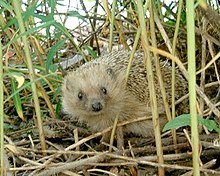| Eulipotyphla Temporal range: ?Late Cretaceous - Recent
| |
|---|---|

| |
| European Hedgehog Erinaceus europaeus | |
| Scientific classification | |
| Kingdom: | |
| Phylum: | |
| Class: | |
| Order: | Eulipotyphla Waddell et al., 1999
|
| Families | |
Eulipotyphla is an order of primarily insectivorous placental mammals that includes hedgehogs, moon rats, shrews, moles, desmans, and solenodons. Members of Eulipotyphla were once placed in the oder Lipotyphla, which also included tenrecs and golden moles. Phylogenetic studies of DNA sequences indicate that tenrecs and golden moles are not closely related to other supposed lipotyphlans, and they have been placed in their own order, Afrosoricida.
The species remaining in the clade Insectivora were then referred to as order Eulipotyphla. After further scrutiny, other evidence now indicates that even Erinaceidae (hedgehogs) should also be placed in a separate order from the remainder, comprising the families Soricidae (shrews), Talpidae (moles), Solenodontidae and Nesophontidae.[1] These two orders, Erinaceomorpha and Soricomorpha, now replace Insectivora. Molecular studies indicate that Soricomorpha is paraphyletic, because Soricidae shared a more recent common ancestor with Erinaceidae than with other soricomorphs.[2]
Some molecular studies, particularly studies of mitochondrial DNA, have separated Erinaceidae from other eulipotyphlans, but this appears to be a product of long branch attraction.[3] Most recent studies support eulipotyphlan monophyly.
Within Eulipotyphla, Solenodontidae is the most basal living family, and the ancestors of Solenodon may have diverged from other eulipotyphlans in the Cretaceous.[2] Talpidae appears to have been the next family to diverge and Soricidae and Erinaceidae are probably sister taxa. Here again, erinaceids are problematic. The base composition of hedgehog DNA is unusual, and this causes a soricids and talpids to group together in some studies.[3]
- ORDER EULIPOTYPHLA
- Family Erinaceidae
- Family Soricidae
- Subfamily Crocidurinae: white-toothed shrews
- Subfamily Soricinae: red-toothed shrews
- Subfamily Myosoricinae: African white-toothed shrews
- Family Talpidae
- Subfamily Desmaninae: desmans
- Subfamily Talpinae: moles
- Subfamily Uropsilinae: shrew moles
- Family Solenodontidae: solenodons
- Family Nesophontidae: extinct West Indian shrews
Family-level cladogram of extant insectivoran relationships, following Roca et al.:[2]
| Eulipotyphla | |
References edit
- ^ Hutterer, R. (2005). Wilson, D.E.; Reeder, D.M. (eds.). Mammal Species of the World: A Taxonomic and Geographic Reference (3rd ed.). Johns Hopkins University Press. pp. 212–311. ISBN 978-0-8018-8221-0. OCLC 62265494.
- ^ a b c Roca, A.L., G.K. Bar-Gal, E. Eizirik, K.M. Helgen, R. Maria, M.S. Springer, S.J. O'Brien, and W.J. Murphy (2004). "Mesozoic origin for West Indian insectivores". Nature. 429 (6992): 649–651. doi:10.1038/nature02597. PMID 15190349.
{{cite journal}}: CS1 maint: multiple names: authors list (link) - ^ a b Cabria, María Teresa; Rubines, Jonathan; Gómez-Moliner, Benjamín; Zardoya, Rafael (2006). "On the phylogenetic position of a rare Iberian endemic mammal, the Pyrenean desman (Galemys pyrenaicus)". Gene. 375: 1–13. doi:10.1016/j.gene.2006.01.038. PMID 16624502.
{{cite journal}}: CS1 maint: date and year (link)